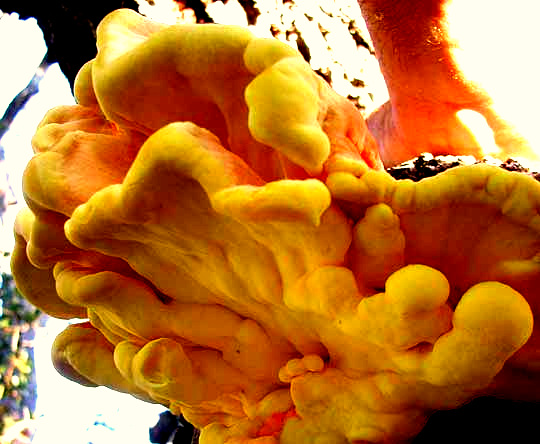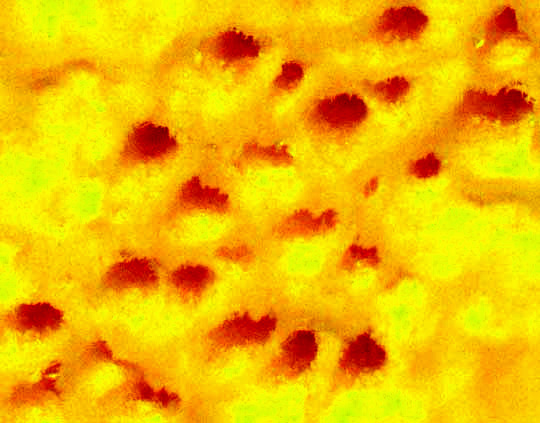Excerpts from Jim Conrad's
Naturalist Newsletter

from the November 25, 2012 Newsletter issued from the valley of the Dry Frio River in northern Uvalde County, southwestern Texas, on the southern border of the Edwards Plateau; elevation ~1750m (~5750 ft); N29.62°, W99.86°; USA
CHICKEN OF THE WOODS MUSHROOM
In this arid region much fewer mushrooms are apparent than farther east. However, we do have some, and this week a certain one has put on a show emerging from a wounded Texas Live Oak along the river. It was a shelf fungus, a stalkless one growing like a fan stuck into the side of the tree, about the size of my hand with fingers spread, and bright yellow-orange. Above you can see it emerging from the cambium area of a circular wound where a large limb had been sawed off.
A view of the mushroom from below, showing its curiously puffy growth, and lack of gills is shown below:

Lacking gills, this member of the polypore group of mushrooms drops its spores from tiny holes or pores on the lower surface. The pores seen below a dissecting microscope are shown below:

In that image most of the pores are still covered with a yellowish membrane. Apparently the membrane stays in place until the spores are mature and ready to fall. In fact, all the pores on the undersurface of the mushroom when it was photographed were covered. Only after waiting a few days, when the mushroom was beginning to fade and maggots had begun tunneling through its flesh, did the pores begin to open, enabling the last picture, and even there you can see that most pores are still covered. This was an interesting discovery, one I've not seen in print.
Among mushroom eaters, this distinctive mushroom is one of the most famous, and one of the best tasting. It's Chicken of The Woods, sometimes also called Sulphur Shelf, LAETIPORUS SULPHUREUS. Back during my hermit days in Mississippi I ate bushels of this mushroom, for it was abundant and often much larger than the one in our picture. About half of the mushroom, the thicker part nearest the wood, is too tough to eat, but the rest is somewhat fibrous like the flesh of chicken breast. Fry it in butter with onions, garlic and chili peppers, scramble it with eggs, and you have some of the finest eating imaginable.
I didn't pick the one in our picture, though, since it was the only one I've seen here, plus it was more infested with maggots than I like.
Usually Chicken of The Woods is a saprobe, which means that it decays wood on dead trees. However, under the right conditions it can become parasitic, sapping nutrients from its host tree, and causing a brown heart-rot. The one in the picture appears to have gone parasitic, for the live oak tree it was growing from appeared healthy, except for the wound formed by sawing off the big branch.
Chicken of The Woods is easy to identify, though there are some non-edible species beginners might confuse it with. To be sure you have a Chicken of The Woods, you should be in the eastern half of North America, or thereabouts, confirm that on the mushroom's undersurface there are pores, not gills, and that the mushroom grows from a tree trunk, and not from roots below the ground or at the ground's surface. Chicken of The Woods normally occurs on oaks so if you find it on a different kind of tree you should be especially wary.
As with many organisms, gene sequencing techniques have revealed a lot of genetic diversity and complexity where earlier we thought things were straightforward. What we're calling Laetiporus sulphureus here recently has been shown to actually be six species that all look alike but occur in different ecosystems and/or perform different ecological roles. However, this information hasn't filtered down to folks like us, so the best we can do is to keep speaking of Laetiporus sulphureus as we did in the old days, waiting to be put right on matters at a future date.